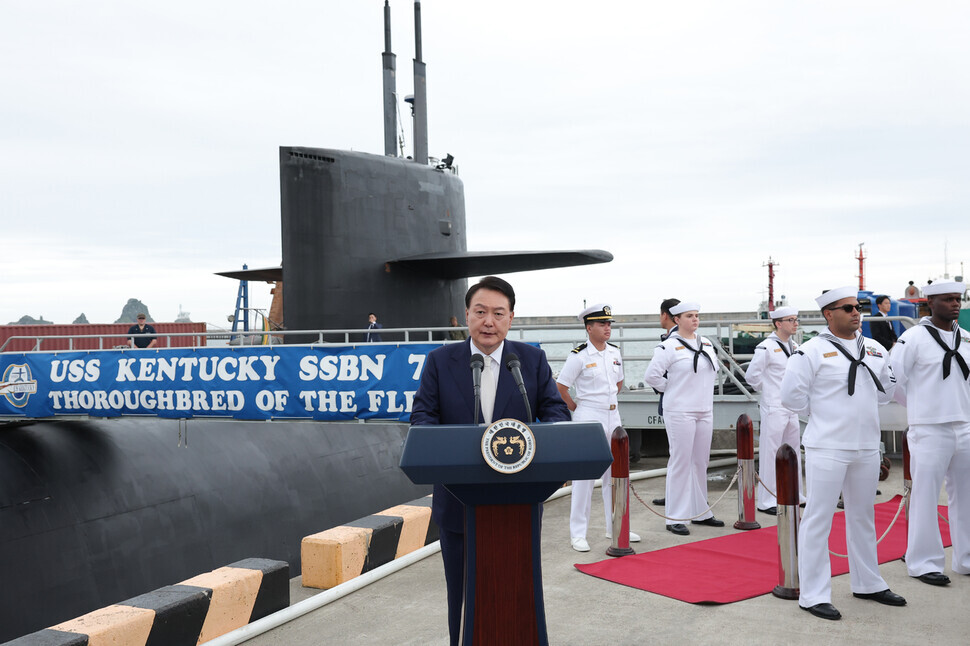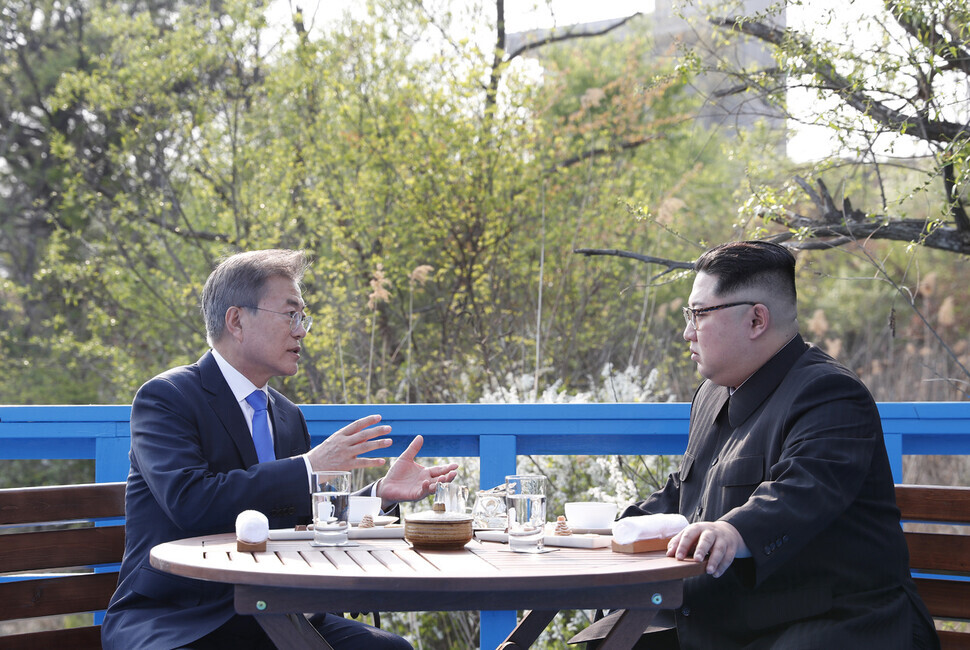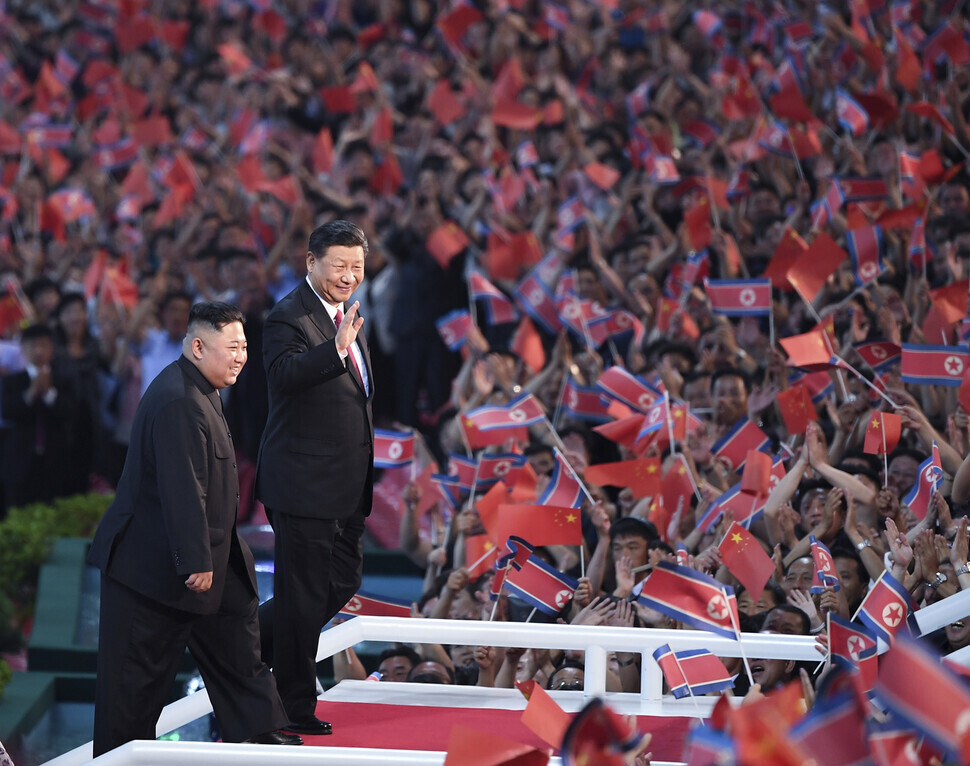hankyoreh
Links to other country sites 다른 나라 사이트 링크
After 70 years of armistice, Korea must dare to hope for permanent peace

The postwar system is the product of mountain warfare at the end of the Korean War. While the high-altitude battles raged for more than two years, countless young people lost their lives, and a garrison state borne out of air strikes took over in North Korea, while an anti-communist regime that justified dictatorships based on the Red Scare was established in South Korea.
Seventy years have passed since an armistice was signed, temporarily halting the war instead of permanently ending it or bringing peace to the Korean Peninsula. The political and social wounds the war left behind still remain intact. With the launch of the Yoon Suk-yeol administration, the “politics of healing” vanished, and South Korea regressed into a war regime. Will we be able to create a postwar system in the true sense of the word?
Mutually assured destruction and those unafraid of warEven after the armistice was signed in 1953, the two Koreas reached the brink of war several times, but no war ultimately came to pass. This was only due to the exercise of restraint by either Korea or the US. On Jan. 21, 1968, armed spies closed in on the Blue House, while two days later, the spy ship USS Pueblo was captured in the coastal waters off Wonsan in North Korea. That fall, over 100 armed guerillas wreaked havoc in Uljin, North Gyeongsang Province, and Samcheok, Gangwon Province. A sort of limited warfare took place.
Park Chung-hee tried to retaliate, but the Lyndon Johnson administration in the US chose to negotiate in order to free its captured crewmen. North Korea wanted political victory out of its year-long negotiations with the US that took place in Panmunjom, and when it accomplished its goal, it released the US crewmen.
In 1976, what’s known in the US as the “Panmunjom poplar tree incident” occurred, during which North Korean soldiers axed to death US soldiers who had been trimming trees for security purposes. In order to attempt to cut down the trees again, the US raised its alert level while deploying aircraft carriers and fighter planes to the sea and the sky. The South Korean military also itched for revenge. If North Korea responded in kind, a war would have broken out. But North Korea took a step back, and the trees came down without further incident.
In 1994, the US wanted to conduct a “surgical” air raid on North Korea’s nuclear facilities in Yongbyon. The US advised its citizens residing in South Korea to evacuate, and panic buying of instant noodles and water ensued in South Korea. Former US President Jimmy Carter visited North Korea, reaching a dramatic negotiation, but the plan to bomb North Korea was already out of the question. The US at the time examined the damage that would result from bombing Yongbyon, estimating that if a full-scale war broke out, 80,000 to 100,000 US soldiers and hundreds of thousands of South Korean soldiers would die, and civilian casualties of over 1 million would occur within 24 hours of the war in Seoul and its nearby areas alone.
30 years have passed since the war crisis in June 1994. North Korea has armed itself with nuclear weapons, and has boosted the might and number of long-range artillery threatening Seoul and its adjacent areas. The military strength of South Korea and the US has also advanced exponentially, defying comparison with what they once were. Compared to what was simulated 30 years ago, the damage a war could do today is beyond imagination. The Korean Peninsula is already a space where mutually assured destruction can take place.
Pro-war discourse at odds with reality has been a through line in the 70 years following the Korean War, starting with the theory of unification through northward advance championed by Syngman Rhee. But having become accustomed to “cold peace” for so long, the public rarely feels the fear of war anymore. What citizen with common sense would want a war? But people dreaming of war are coming out of the woodwork once again. I only hope the government doesn’t forget its 70-year postwar historical consciousness, its duty to protect and nurture peace, and its responsibility to safeguard the lives and property of the citizenry.
Common denominator of summits of 2000, 2007, 2018There were not an insignificant number of opportunities for peace during the 70 years following the Korean War. In 1997, the Roh Tae-woo administration signed the Inter-Korean Basic Agreement and the Agreement on Reconciliation, Non-aggression, and Exchanges and Cooperation with North Korea. The two Koreas promised to transition from an unstable armistice regime to a permanent peace regime at the time. They also agreed on a very detailed and specific plan to build military trust that didn’t need any documentary addendums. Military agreements in the 30 years since have not veered from it one bit.
But the conditions that enabled the Inter-Korean Basic Agreement didn’t last long. Faced with unfavorable circumstances — namely, the fall of the socialist bloc — North Korea entered the diplomatic stage, but due to the death of Kim Il-sung and economic difficulties, it prioritized the maintenance of the status quo. Meanwhile, in South Korea, conservatives reorganized themselves during the second half of the Roh administration.

The Kim Young-sam administration heralded the emergence of neo-conservatives, who approached inter-Korean relations as if it were a matter of domestic politics. Opportunities were missed due to the controversy surrounding whether condolences should be offered for Kim Il-sung’s death, and a gap in inter-Korean relations opened up for five years.
The US plays an important role in the process of creating a peace regime. There’s one thing in common in the conditions that enabled inter-Korean summits in 2000, 2007, and 2018. Namely, the three bilateral relations making up the triangular relationship amongst South Korea, North Korea, and the US — in other words, inter-Korean relations, South Korea-US relations, and North Korea-US relations — cleared up at the same time, forming a virtuous cycle. In all three instances, the US didn’t make the first move. The South Korean government persuaded the US by loosening up its relations with North Korea, moving North Korea-US relations.
Why is the US important? Because US sanctions against North Korea always either opens up a window for inter-Korean relations or closes it, because the US is the party responsible for bringing about a peace regime as a reciprocal measure for North Korea abandoning its nuclear weapons program, and because relations between North Korea and the US should be normalized to realize the true end of the Cold War.
The problem is that solving the “North Korea problem” is low on Washington’s list of diplomatic priorities. As reaffirmed by the process through which the Hanoi summit in February 2019 broke down, negotiating with North Korea does not help the White House with domestic politics.
The US is reorganizing its military strategy to focus on deterring China. It’s attempting to expand the United Nations, which oversees the armistice regime, like NATO. Though the UN has pretty much already transferred its duty of armistice management to the South Korean military, it still exercises legal and institutional authority when it comes to important matters like entry into the Demilitarized Zone or violations of the armistice regime. The UN also plays a critical role in the controversy surrounding an end-of-war declaration. An end-of-war declaration is a stepping stone toward a peace treaty.
Overlooking North Korea-China relations led to failing North Korea-US talksDiscussions over the role and function of the UN are at the center of South Korea-US talks concerning the transition from a state of armistice to declaring the end of the war. Of course, it was easy for the US and South Korea to agree on a plan to maintain the armistice with mere political gestures, but that was not enough to convince North Korea, which insisted on more practical measures. With the change in the order in the Korean Peninsula, the journey towards a peace treaty proves to be a rocky road.
As of now, peace on the Korean Peninsula seems to be beyond our grasp as strategic competition between the US and China intensifies. The Korean War was both a civil war and an international one, with the US and China participating as important parties. Naturally, US-China cooperation is essential for the transition from an armistice to actual peace.
In the past, both the 1997 four-party talks on the Korean Peninsula and the 2000 six-party talks to resolve the North Korean nuclear weapons issue were made possible by cooperation between the US and China.
The thaw on the Korean Peninsula in 2018 was the most recent time such an opportunity arose. While the relations between South Korea, North Korea, and the US are usually the main focus of analysis when inspecting the period of “spring” represented by the Pyeongchang Olympics in 2018 to the “winter” of the Hanoi summit in February 2019, there was a more important variable: Relations between North Korea and China.
There were four summits between North Korea and China during this period, all of which involved Kim Jong-un visiting China. These were the first summit Kim Jong-un took part in since taking power seven years prior.
In June of 2019, President Xi Jinping visited North Korea. While Kim made his calls on South Korea, he still secured a way out through the back door to the north.
Though harder to see at the time, it’s now clear that North Korea focused most of its energy on its relationship with China during that period. If cooperation between the US and China, as well as cooperation between South Korea and China ,had complemented the South Korea-North Korea-US triangle, it would have been possible to at least resume negotiations.
In the end, by overlooking the importance of the North Korea-China relationship, which was a key variable in the process of creating peace on the Korean Peninsula, the opportunity to negotiate for peace was lost.
With the US and China now engaging in strategic confrontation, the order on the Korean Peninsula has changed. Naturally, the possibility of the emergence of a diplomatic solution that sets a line between cooperation for peace on the Korean Peninsula and the strategic competition between the US and China has also disappeared.

North Korea’s growing nuclear arsenal has made negotiations less and less likely. Yoon’s presidency emerged in a context of deepening mistrust following the failure of the Hanoi talks in 2019. It is difficult for the US to make a move when the South Korean government insists that dialogues and negotiations only call for “false peace.”
Some argue that if North Korea strengthens its nuclear arsenal, as it did in the aftermath of the 1994 Geneva talks, the US may be willing to negotiate regardless of South Korea’s intention, but this is highly unlikely.
Negotiations with North Korea are politically unattractive within the US, and the prospect of a deal is not worth the risk. There is also a crucial difference from the past in that the US sees North Korea’s strategic provocations as an opportunity to build a trilateral military cooperation system with the US, South Korea, and Japan to deter China.
Ideological rigidity falling out of favor with the timesYes, choosing to be optimistic may show that you have your head in the clouds, while being pessimistic demonstrates how in touch you are with reality. But how can we get through this time of despair if we don’t dare to hope?
Here, hope does not mean merely wishing for the “good old days.” We need to be clear about the changing order around us. The era of US-China cooperation, globalization, post-Cold War, and nationalism is coming to an end. The transition period will not be short, and the destination is unknown. In the era of complexity, the only wisdom is flexibility. Forces armed with ideological rigidity will surely fall out of favor with the times.
History does not form a straight line, but is slightly curved. It seems to go backward as much as it goes forward, and forward as much as it goes backward, but in the long run, progress is still made. Just as water flowing under the ice delivers spring, we must endure the time of regression and prepare for a future of peace. President Kim Dae-jung is right in his belief: “Life is beautiful and history progresses on.”
By Kim Yeon-chul, former minister of unification and current professor at Inje University
Please direct questions or comments to [english@hani.co.kr]
Editorial・opinion
![[Editorial] Intensifying US-China rivalry means Seoul must address uncertainty with Beijing sooner than later [Editorial] Intensifying US-China rivalry means Seoul must address uncertainty with Beijing sooner than later](https://flexible.img.hani.co.kr/flexible/normal/500/300/imgdb/original/2024/0517/8117159322045222.jpg) [Editorial] Intensifying US-China rivalry means Seoul must address uncertainty with Beijing sooner than later
[Editorial] Intensifying US-China rivalry means Seoul must address uncertainty with Beijing sooner than later![[Column] When ‘fairness’ means hate and violence [Column] When ‘fairness’ means hate and violence](https://flexible.img.hani.co.kr/flexible/normal/500/300/imgdb/original/2024/0516/7417158465908824.jpg) [Column] When ‘fairness’ means hate and violence
[Column] When ‘fairness’ means hate and violence- [Editorial] Yoon must stop abusing authority to shield himself from investigation
- [Column] US troop withdrawal from Korea could be the Acheson Line all over
- [Column] How to win back readers who’ve turned to YouTube for news
- [Column] Welcome to the president’s pity party
- [Editorial] Korea must respond firmly to Japan’s attempt to usurp Line
- [Editorial] Transfers of prosecutors investigating Korea’s first lady send chilling message
- [Column] Will Seoul’s ties with Moscow really recover on their own?
- [Column] Samsung’s ‘lost decade’ and Lee Jae-yong’s mismatched chopsticks
Most viewed articles
- 1[Editorial] Transfers of prosecutors investigating Korea’s first lady send chilling message
- 2For new generation of Chinese artists, discontent is disobedience
- 3S. Korea “monitoring developments” after report of secret Chinese police station in Seoul
- 4Xi, Putin ‘oppose acts of military intimidation’ against N. Korea by US in joint statement
- 5[Exclusive] Unearthed memo suggests Gwangju Uprising missing may have been cremated
- 6N. Korean media upgrades epithet for leader’s daughter from “beloved” to “respected”
- 7Yoon says concern about biased diplomacy is being incited by “communist totalitarian forces”
- 8[Editorial] Intensifying US-China rivalry means Seoul must address uncertainty with Beijing sooner t
- 9[Column] Samsung’s ‘lost decade’ and Lee Jae-yong’s mismatched chopsticks
- 10[Special reportage- part I] Elderly prostitution at Jongmyo Park